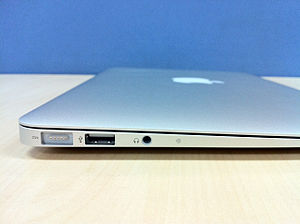Design
The MacBook Air is designed for thinness; it is also lighter than most competing models. It was the first MacBook produced using a single sheet of aluminum with Apple's unibody technique.[15][16] The computer features a glossy LED backlit display and a full-size keyboard, as well as a large trackpad that responds to iPhone-like Multi-Touch gestures such as pinching, swiping, and rotating.[17] With the release of Mac OS X Snow Leopard, the Air's multi-touch trackpad also supports handwriting recognition of Chinese characters.[18]
On the 11-inch MacBook Air, the left side of the computer has a MagSafe power connector, a USB port, a headphone jack, and a microphone.[1][17] The right side of the computer has a USB port and a Mini DisplayPort. On top of the screen bezel there is an iSight webcam, which has now been dubbed the FaceTime camera.[1][17]
The MacBook Air was the first subcompact laptop offered by Apple since the full-featured 12" PowerBook G4 was discontinued in 2006. It was also Apple's first computer with an optional solid-state storage drive.[19] ArsTechnica found "moderate" performance improvements of the 64GB[note 1] solid-state drive of the first generation Air over the standard 80 GB hard drive in tests. On October 14, 2008, new models were announced with improved capacities of 128 GB (solid-state) and 120 GB (hard drive).[20] For the late 2010 MacBook Air, only SSD storage is available, in 64 or 128GB capacities on the 11" model, and 128 or 256GB on the 13".
The MacBook Air comes standard with 2 GB RAM, which is fixed and non-upgradeable[note 2][20] Buyers of the late 2010 MacBook Air have the option to specify 4GB of RAM at the time of purchase.
The CPU in the original MacBook Air was a custom Intel Core 2 Duo Merom chip that was 40 percent of the size of the chips publicly available at that time.[21] The CPU was replaced with a standard low-voltage Core 2 Duo Penryn chip with 6 MB of cache, running on a 1066 MHz bus for all models since late-2008.[22]
The MacBook Air has no user-replaceable parts. The flash memory, RAM, and battery are enclosed within the casing, with RAM soldered directly to the logic board. The flash memory, while not soldered directly to the logic board, is engineered to be extremely difficult to access, and has an mSATA connection to the logic board.[23][24] The MacBook Air's battery is enclosed within the case but can be replaced using normal screwdrivers, though it is unclear whether this process would void the computer's warranty.[25][26] As part of the out-of-warranty service, Apple offers to replace the battery for a fee.[27]

Apple incorporated several features in the design of the MacBook Air, such as the reduction of toxic chemicals like lead, to make it more "environmentally friendly". The MacBook Air contains no BFRs and PVC wiring, meets Energy Star Version 5.0 requirements, has a recyclable enclosure, and is rated EPEATGold; its display is made from arsenic-free glass and does not contain mercury.[1][28][29] To reduce the computer's size and weight, several features were sacrificed. It was Apple's first notebook since the PowerBook 2400c without a built-in removable media drive.[30] It also omits a FireWire port, Ethernet port,line-in, media card slots (except the 13" 2010 model, which has an SD card slot), and a Kensington Security Slot.[31]
To regain the features of an optical drive, users can either use a separately-available external USB SuperDrive, or the bundled Remote Disc software to access the optical drive of another computer. However, this method only allows for disk browsing or software installation; DVD movies or CDs cannot be watched or listened to.[1][32] The Remote Disc capability is achieved by the computer wirelessly accessing the optical drive of another Mac or Windows PCthat has the Remote Disc program installed.[33][34] It can also be used to reinstall the system software from the included installation DVD.[35] Remote Disc supports netbooting, so the MacBook Air can boot from its installation DVD in another computer's drive. This feature requires Remote Install Mac OS X to be running on the remote computer. The software does not allow the playback or information of DVDs or CDs, nor does it allow the installation of Microsoft Windows.[32] For these features, an external USB drive is required.[32] The 2010 revision includes two speakers for stereo sound while earlier versions have a single speaker located under the keyboard.[1]
The MacBook Air includes Mac OS X Snow Leopard pre-installed, along with Apple's iLife multimedia suite.
With the 2008 revisions of the notebook, wired Ethernet connectivity required a separately available USB-to-Ethernet adapter. However, for the 2009 revision, the adapter is included in-the-box.[36]Additionally, in the 2008 revision, the hard drive, graphics, front side bus, processor, memory, battery, and port connections were upgraded.
[edit]
